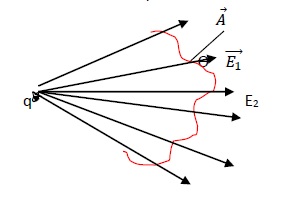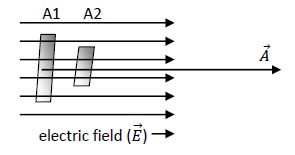Electric Flux Measurement
Description:
Let there be a charge, creating electric field all around it. The field lines in the diagram represents the direction of electric field and the irregular dark line represents the surface in which electric field is getting linked.

Considering the magnitude and direction of electric field at every point is different.
To calculate the amount of electric flux linked with this area; Take an infinitely small area Or unit vector area (dA) at different places as shown in fig. and let the angle between electric field (E1) and a unit area be θ1.
So, the small electric flux due to this small area is given by −
Φ1 = E1dAcos θ1
Similarly for another small area in electric field E2, and angle between them as θ2. The small electric flux is given by −
Φ2 = E2dACos θ2
Similarly, Φ3 = E3dACos θ3 and so on.
So, the total electric flux due to complete area and in total electric field will be given by the integration of all the electric flux due to each unit area.
Therefore;
ΦE = 0 ∮dΦ
ΦE = ∮ E dACos θ
This is the general formula of electric flux. This is used when there is irregular surface and the electric field is non uniform.
When there is a uniform electric field (E→) in which a regular area(A→) is placed. The direction of E→ and A→ is shown in fig. In that case the flux will be equal to

ΦE = E ∮ dACos θ
Where θ = 0. as the direction of electric field and area are parallel to each other.
So, ΦE = E ∮ dACos θ
(Since the electric field is uniform so ‘E’ is taken as constant)
For total electric flux in complete area is given by integrating dA within limit 0-A, we get −
ΦE = E A∮0 dA

